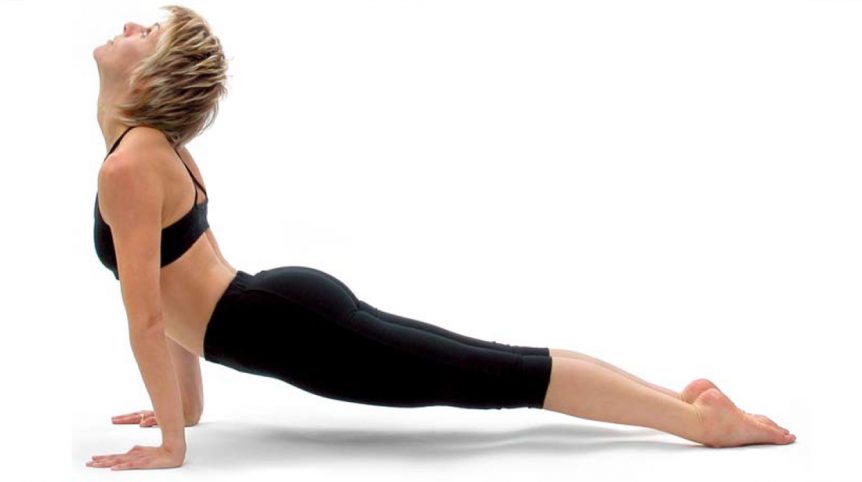by Simon Borg-Olivier MSc BAppSc(Physiotherapy) and Bianca Machliss BSc BAppSc(Physiotherapy)
For those of you who are new to the YogaSynergy method here is an article that takes a deep dive into the background of how it all started over 35 years ago.
The Yoga Synergy style of yoga, also simply known as YogaSynergy, is traditional hatha yoga with an understanding from exercise based physiotherapy.
Our unique style of yoga is very fluid and dynamic and has been developed in Sydney since the 1980’s by Simon Borg-Olivier and Bianca Machliss.
It incorporates all the postures seen in other popular yoga’s but also includes many novel postures and exercises that do not appear elsewhere.
Although strength, flexibility and cardiovascular fitness can be by-products of practicing YogaSynergy, they are not the main aim. The main aim of yoga is communication and the realisation that we are all connected.
The main physical aim of YogaSynergy is the enhancement of the flow of energy and information through the various channels of the body. When this is understood then a YogaSynergy practice can leave you energised yet calm, with a reduced need for food and sleep. In addition, because this system enhances the flow of information though the body it can be used to heal many injuries and illnesses, and can prevent many of the common yoga-based injuries from occurring.
The YogaSynergy System has been developed over a 35 year period based on the teaching we have been lucky enough to receive from our yoga teachers and our understanding of the theory and practice of the yoga anatomy and yoga physiology as research based scientists and physiotherapists.
The YogaSynergy System can be adapted to any system of physical exercise, but it is most easily and effectively applied in the five specific sequences designed and refined by Simon and Bianca over a 10 year period during from 1989 to 1999.
These specifically designed sequences are named after the elements Earth, Water, Fire, Air and Ether and can be practiced by an experienced practitioner over a five day cycle that can also include a single day of long inverted positions and a day of purely meditation and rest to give a weekly cycle.
Each sequence is taught and practiced at seven main levels ranging from Beginner to Advanced. Studies in exercise based physiotherapy have shown that repetition is important for learning, therefore learning a set sequence is important, but because training is specific it is also important to vary the approach to learning something like a sequence of exercises.
Initially each sequence is taught progressively over a nine week period and in each class the group level and circumstances such as weather, time of day and general energy at the time of the class taken into account.
YogaSynergy encourages practitioners to approach their practice intelligently and use it as a tool to enhance their lives. One of the main methods of doing this is to have variations for each of the postures, ranging from a simple (easy) version to a more complex (difficult) version.
All practitioners are taught the simple versions and are encouraged to use those when they are not feeling 100% and thus are still able to practice. As a result many different versions of the basic form of any of the sequences are available and we have classes of people with many different types of bodies and levels of experience enjoying their practice together.
It was never our intention to create a particular style of yoga. Initially we practiced the yoga we were taught our main teachers Natanaga Zhander (Shandor Remete), Sri B.K.S. Iyengar, Sri K. Pattabhi Jois and Sri T.V.K. Desikarchar. These great masters helped us greatly in our own path of yoga.
However, after many years of practice and teaching we realised that we had missed something in our understanding of the body. So we both went back to university and studied to become physiotherapists. This dramatically changed the way we approach our yoga practice and teaching and over the next few years a unique style, YogaSynergy, began to emerge almost by itself.
The main features of YogaSynergy are:
- Modification of traditional yoga postures and sequences to take
account of the modern body and variations between practitioners - Gradation of postures with a personal choice ranging from simple
(easy) to complex (difficult) versions of each posture or sequence - Use of active movements to enter each pose
- Use of resistance work during each pose
- Use of co-activation (simultaneous tensing) of the muscles around the
nine main joint complexes of the body in order to stabilise these joints - Use of seven circulatory pumps to aid in the movement of energy and
information through the body - Use of special mudras (energy control gestures) that can tension
(stretch) nerves and acupuncture meridians - Use of specific breath-control to gradually reduce the amount of air
required per minute in order to lessen the need for sleep and food,
bring more oxygen to the brain and calm the nervous system
1. Modification of traditional yoga postures and sequences to take account of the modern body and variations between practitioners:
Traditional hatha yoga is taught with the assumption that those practicing it have traditional Indian bodies and/or are beginning yoga practice at a young age. Generally, in the modern world, where yoga has become very popular, this is not the case. In general, people living in India may very easily come to the squatting position, something they have been doing since they were children. Similarly, they can readily do the lotus position because of a lifetime of sitting cross-legged on the floor as opposed to sitting on chairs.
Many traditional yoga sequences place deep squats and full-lotus or half-lotus postures relatively early on in the sequence without allowing much time to warm up the hips, knees or ankles. These postures are not considered to be deep or difficult stretches for the traditional Indian body. Yet they are often the cause of injury and found quite difficult by most people, especially when starting yoga practice over the age of 20.
YogaSynergy does not assume that the practitioner has natural flexibility. Postures are sequenced in such a way that one posture prepares the body for the postures to come after it. Each posture can also be modified to take into account the stiffness that tends to be prevalent in typical modern bodies.
2. Gradation of postures with a personal choice ranging from simple
(easy) to complex (hard) versions of each posture or sequence:
With YogaSynergy each pose can be modified by each individual so that they can balance the needs of their body mind at that time. Flexibility in this system is to do with the mental flexibility to do each posture or exercise in such a way that it supports your current needs. Some examples include the following. If the back of the legs are stiff when bending forward (Figure 1a), then simply bend the knees (Figure 1b). When a one legged balance is not possible simply come to the toe-tips of one leg. If balancing on the hands is not possible then simply lean on the hands.
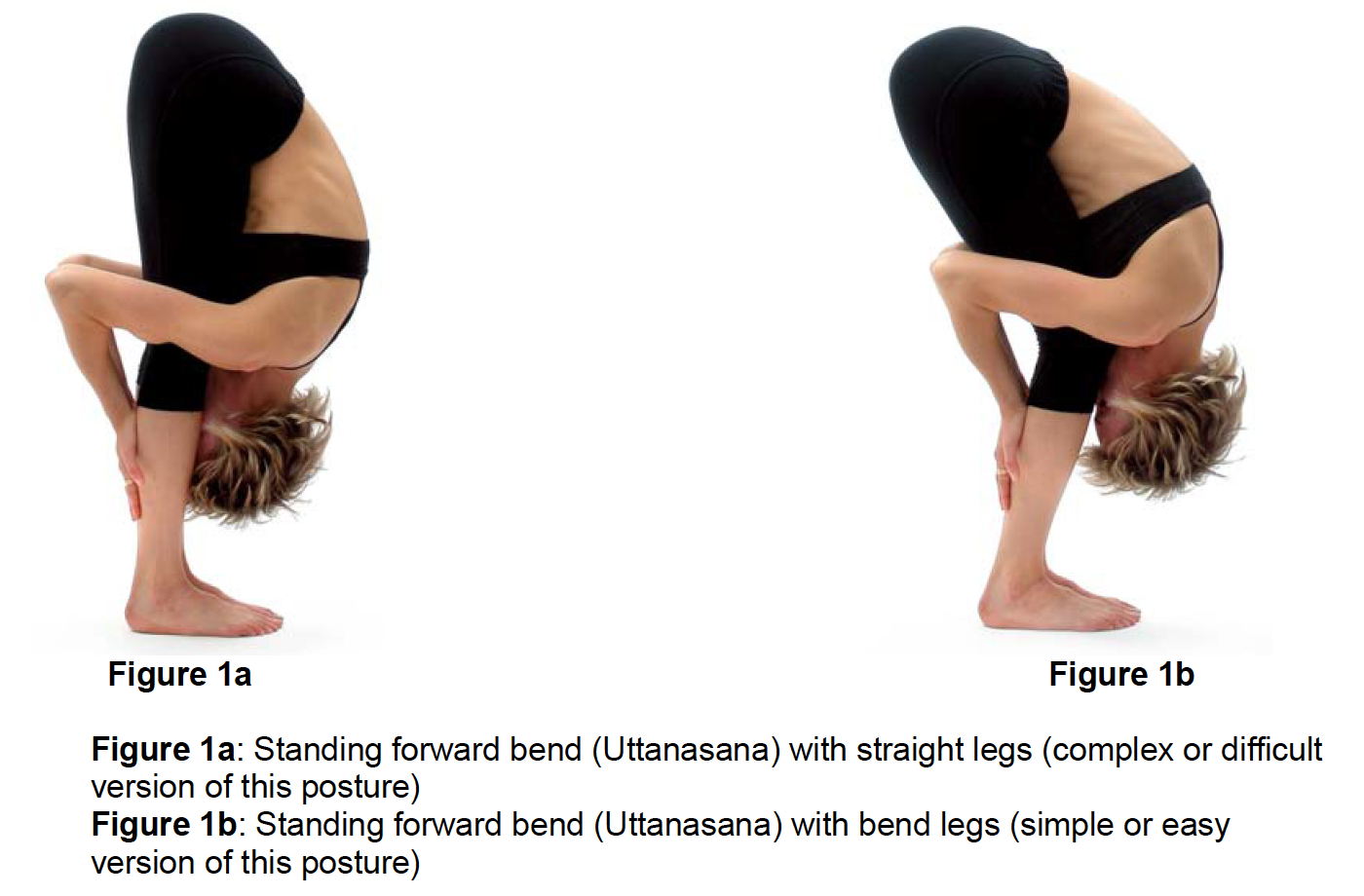
3. Use of active movements to enter each pose:
One misconception of yoga is that it is all about stretching or relaxation. In fact, learning how to activate (tense) muscles and strengthen the body is as important as learning how to stretch and relax muscles.
YogaSynergy appreciates that to achieve the healthiest physical body as well as the best physical yoga you need to have a controlled balance between strength and flexibility as well as the ability to relax. This brings consciousness and awareness throughout the whole body, which is an important aim in physical yoga.
Many problems can manifest in the body if it forced to ‘bend’ too far or if you over-stretch ligaments.
YogaSynergy uses the ‘active movement’ approach in which you only take the body as far into a pose as it can go by itself without the aid of gravity. For example instead of letting the body bend with gravity into a potentially damaging soft spined ‘upward facing dog pose’ (Figure 2a) one can simply lie on the abdomen and lift the chest and hands (Figure 2b). This method forces the body to bend only as far as it is actively capable to bend while building strength at the same time. Using this approach in all the poses helps to simultaneously develop strength, flexibility, fitness and the ability to relax. Active movements are a necessary prerequisite of doing many advanced postures safely (e.g. Figures 3b, 4b and 5b).
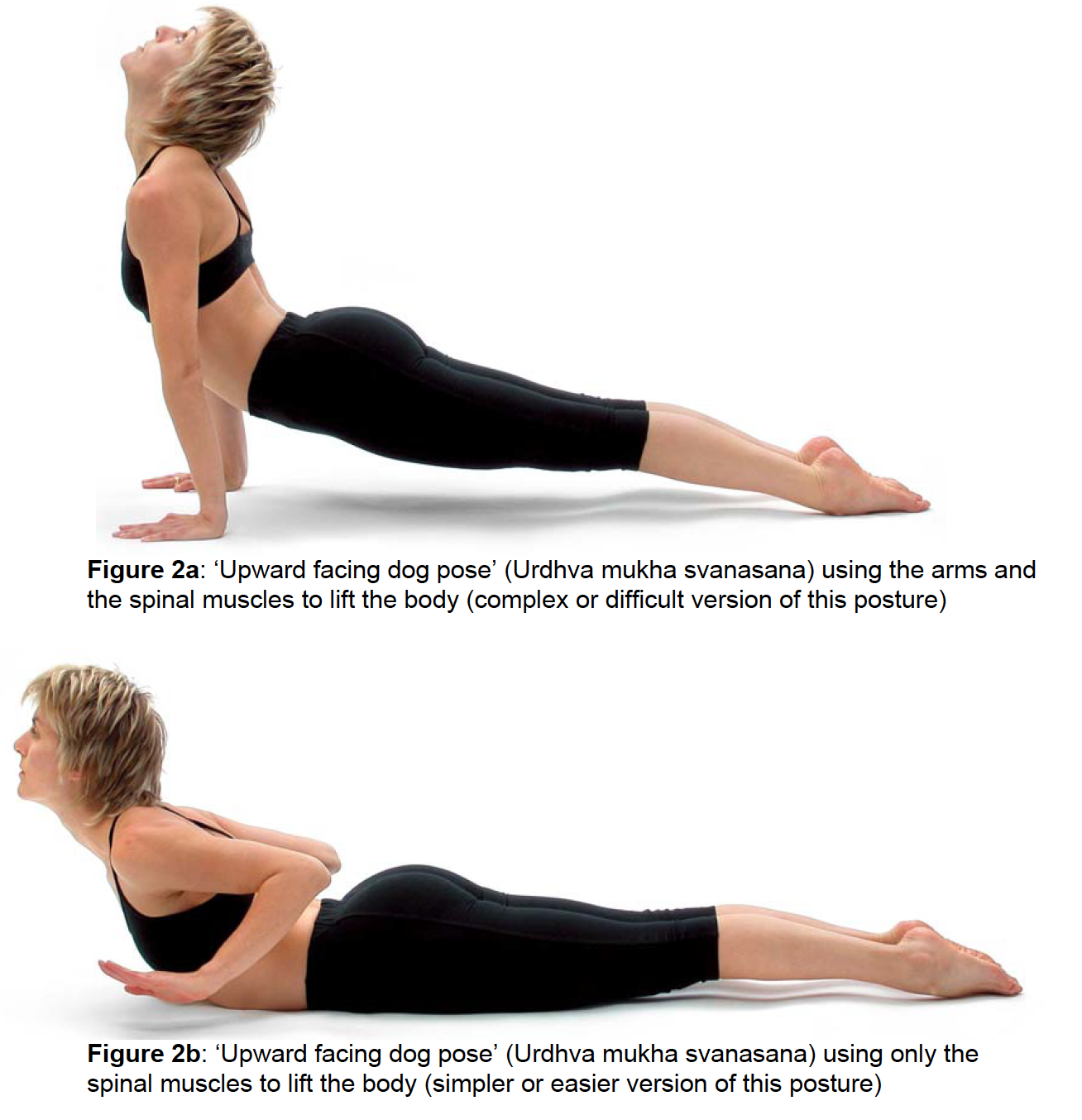
4. Use of resistance work during each pose:
In YogaSynergy, resistance can be applied in each position at each joint. If a muscle is tensed for a few seconds or more while it is being stretched it not only strengthens the muscles involved, but also stretches them further and allows them to subsequently relax more easily.
For example, if you are doing a forward bending postures such as the simple cross-legged forward bend (Figure 3a) or the advanced lotus arm balance (Figure 3b), it is mainly the buttocks muscles that are being stretched. You can tense the buttocks by trying to press the feet towards the floor. This not only rapidly stretches, strengthens and subsequently relaxes the buttocks but can also help the health of the lower back.

Another example of how resistance can be used is the simple lunge posture (Figure 4a) which stretches the front of the groin. In the lunge you can tense the front of the groin while it is being stretched by trying to press the two feet together or by trying to ‘squash the mat with your feet’. This action not only quickly stretches, strengthens and subsequently relaxes the front groin but can also help the health of the spine. Similar but more complicated processes can be applied in the ‘advanced balancing lunge’ shown in Figure 4b.
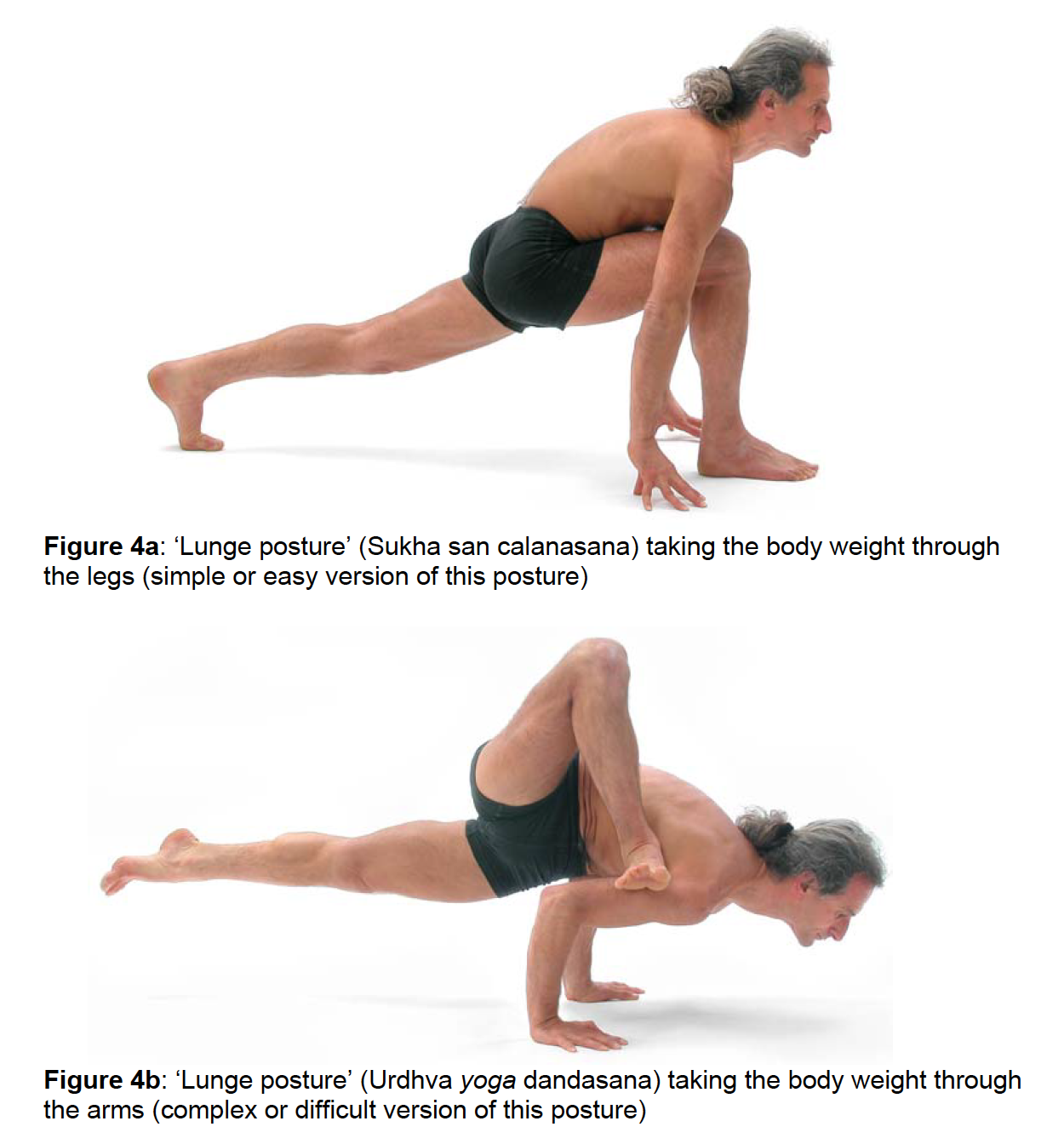
The use of active movements and resistance work in YogaSynergy allow muscles to be trained through the full range of joint movement.
5. Use of co-activation (simultaneous tensing) of the muscles around the
nine main joint complexes of the body in order to stabilise these joints:
In recent times there has been a lot written about core stabilisation and its benefits for health of the lower back. Core stabilisation is essentially the same as the co-activation or simultaneous tensing of the muscles around the lower trunk. In yoga this is called bandha (internal lock).
Most yoga only refers to three main bandhas but YogaSynergy incorporates nine bandhas that are very effective at stabilising and strengthening the entire body. These bandhas are sometimes referred to as the ‘yogi’s suit of armour’. Understanding and applying the nine bandhas not only helps fix spinal problems but also helps fix problems of the ankles, knees, hips, shoulders, elbows and wrists.
6. Use of seven circulatory pumps to aid in the movement of energy and
information through the body:
The heart is usually thought of as the main circulatory pump of energy and information in the body, but in fact it is only effective in pumping the blood about metre from the heart. There are six other pumps that are taken advantage of by YogaSynergy to enhance circulation.
- The gravitational pump functions to improve circulation when posture is
changed in the field of gravity. - The musculoskeletal pump works to pump blood in the veins to the heart
when muscles contract then relax. This can be done either voluntarily or as
you move in and out of postures. - The respiratory pump works to enhance the flow of blood to heart as the
chest expands and retards the flow of heart as the chest contracts. - The postural pump works by physically compressing one part of the body
and ‘pushing’ the blood further from that part, and by stretching another part
of the body, which ‘pulls’ the blood towards that region. - The co-activation (bandha) pump works to effectively move energy and
information through the body at will because each of the bandhas has two
opposing forms. There are positive or high pressure bandhas that push the
energy away from a joint and negative or low pressure bandhas that pull
energy and information toward that joint. For example, a high pressure
bandha can be made around the wrist by making a closed fist, which pushes
energy away from the wrist, while a low pressure bandha can be made
around the wrist by stretching the fingers, which pulls energy towards the
wrist. - The centripetal pump uses the circular motions of the bones around their
joints to move blood (and energy and information) mainly to the extremities.
The centripetal pump becomes more effective the faster the body moves.
7. Use of special mudras (energy control gestures) that can tension (stretch) nerves and acupuncture meridians:
YogaSynergy uses knowledge of the pathways of nerves and acupuncture meridians to tension (stretch) some nerves where appropriate. For example, opening the palms with the shoulders pushing towards the hips and rotating outwards (Figure 5a) stretches the median nerve and the lung acupuncture meridian. Bending the elbow and taking the fingers to the shoulders stretches the ulnar nerve and the heart acupuncture meridian (Figure 5b).
YogaSynergy can also lessen the tension (stretch) of other nerves that have been unintentionally and dangerously stretched in stiffer people such as those going down the back of the spine and the legs (Figure 1b).
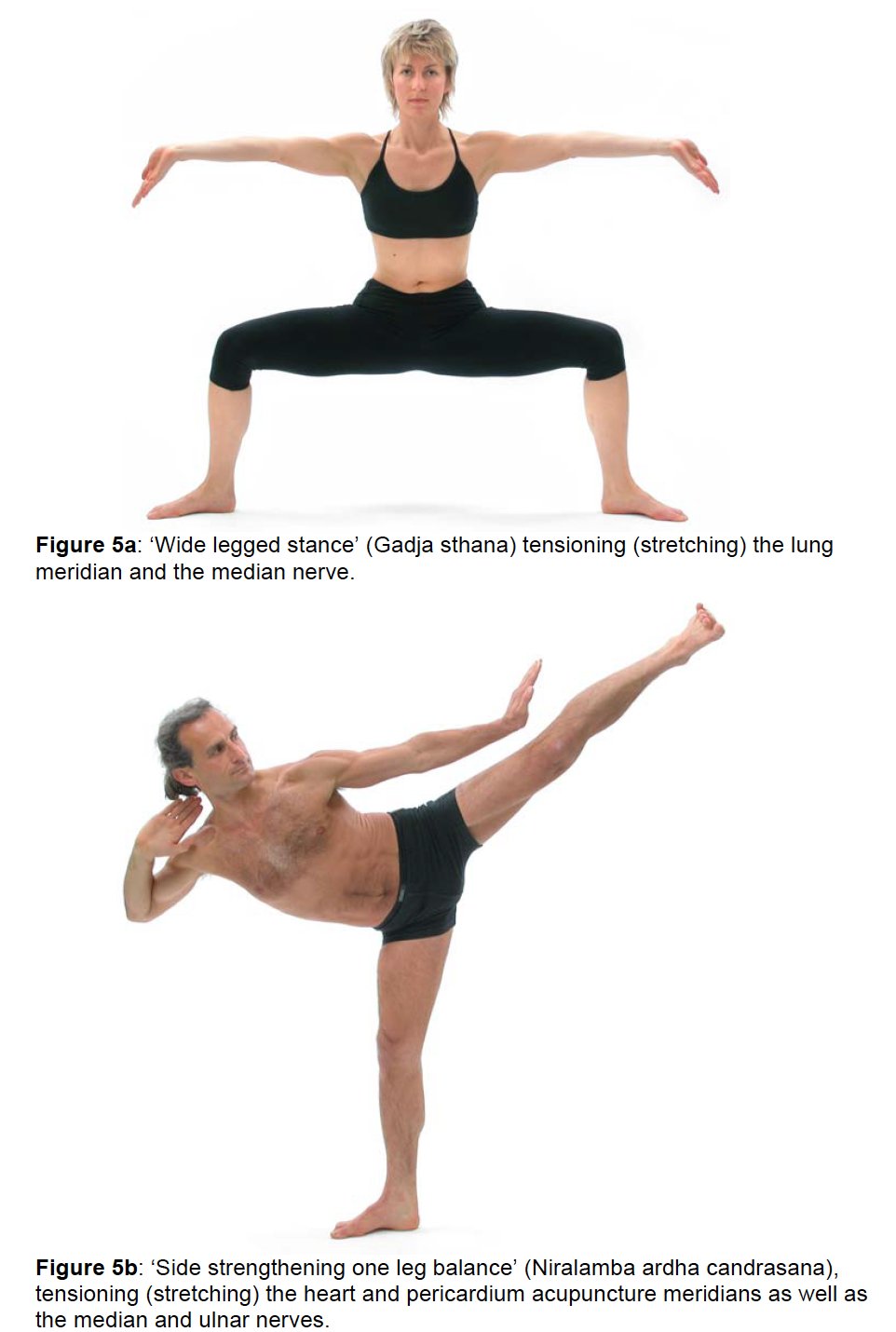
8. Use of specific breath-control to gradually reduce the amount of air required per minute in order to lessen the need for sleep and food, bring more oxygen to the brain and calm the nervous system:
Most exercise and yoga encourages hyperventilation (breathing more than you actually need) which stimulates the nervous system and encourages you to eat heavy food after practice. YogaSynergy initially guides people to use their own natural breath while learning a new posture or exercise. Then, when a satisfactory level of comfort is achieved, YogaSynergy (like traditional hatha yoga) encourages hypoventilation (breathing less than you think you need).
YogaSynergy generally encourages complete exhalations. These tend to clear the lungs of stale air, help to firm or stabilise the spine and help to build up the carbon dioxide in the blood, which is so important in enhancing circulation and bringing oxygen to the brain, heart and cells. YogaSynergy inhalations are initially taught as gentle abdominal (diaphragmatic) breaths performed while retaining a postural firmness of the spine. This helps to calm the nervous system and enhance the functioning of the digestive, reproductive and immune systems.
In more advanced YogaSynergy all the movements of the chest and abdomen are important to practiced at some stage through the breath cycle it is the ventilation (amount of air coming in and out of the lungs per minute) that has the most important physiological effects on the body. Reduced ventilation builds up carbon dioxide in the body. Carbon dioxide is not a poison as many people think, but is in fact a substance that helps to calm the nerves, expand the blood vessels, and reduce the need for sleep and food.
A flexible approach to your yoga practice
One of the most important features of the YogaSynergy Style is the flexible approach it adopts for each practice. The main guiding principles of YogaSynergy come from the Bhagavad Gita, the ancient Indian poem contained in the classic Indian text the Mahabharata, and the Patanjali Yoga Sutras. Loosely translated these say...
‘Don’t be attached to the fruits of your actions but rather be engaged in the actions themselves. Don’t be attached to either success or failure, but don’t be attached to laziness either. Yoga is this balance between doing your best (tapas) without being aggressive or violent in body or mind (ahimsa) and then being content with the outcome (santosa).’
...This means that each YogaSynergy practice can be appropriate for your body in the here and now.
YogaSynergy can be strong when you need strong practice or soft when you need soft practice. Energising or calming as you need. The secret of flexibility has nothing to with the body. Flexibility is all about your mind!
Refererence:
Borg-Olivier, S.A. and Machliss, B.E. (2007) ‘The Applied Anatomy and Physiology of Yoga’. Yoga Synergy PL. For sale in our online shop in hardcopy and as a download.
Share this Post

